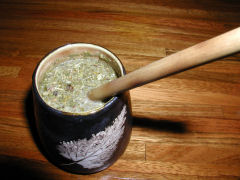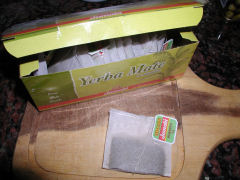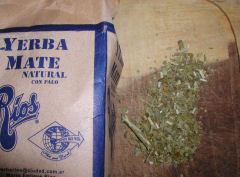Buenos Aires – I’ve resisted talking about mate (pronounced mah-tey; the name in total – yerba mate) for a couple of reasons. First and foremost, if you’d have asked me not too long ago, I would have told you it tastes like badly brewed insipid green tea. Second, it’s a complicated topic here in Argentina – it is, in essence, the national drink. It can be the subject of long, involved, and sometimes (no pun intended) heated arguments. According to google, there are 300,000 websites out there that talk about the stuff – not quite the 53 million that talk about coffee or 26 million that talk about tea – but enough to spend a long time researching the topic.
Mate is prepared from the dried and chopped leaves of a shrub, a member of the holly family. It is brewed much like tea would be, but with some serious differences. There is an art to packing the leaves into the matero or mate, the cup from which it is to be drunk, and to the placement of the bombilla, or small metal or wood straw that it is drunk through. This art can sometimes get as complicated as a Japanese green tea ceremony, depending on the cebador, the person brewing it. And it is ceremony. While it’s perfectly acceptable to drink mate alone, and many folks do, the drink is a social drink, and the usual process is one of sharing, somewhat like a peace-pipe, around the social circle. The cebador packs and then brews and drinks the first cup, ensuring that the fine particulate matter is cleared and that the mate is of good quality. He then refills the cup and passes it to the first person, who drinks and hands it back. This is repeated with each person in turn, until all have had a drink. This continues until the mate is washed out – depending on the grade of leaves that can be anywhere from ten to fifteen or so refills.
 Generally mate is drunk by itself, i.e., with no additives. There are some folk who prefer it sweet and sprinkle a spoonful of sugar on top of the leaves before each refill. Depending on the type of matero, hosts may keep separate ones for sweet and non-sweet, especially if their materos are the traditional hollowed out gourds. Materos can be as simple as a mere scooped out and dried gourd and as elaborate as hand formed and inlaid metal and jeweled cups. Here is a picture of my new, and first, matero.
Generally mate is drunk by itself, i.e., with no additives. There are some folk who prefer it sweet and sprinkle a spoonful of sugar on top of the leaves before each refill. Depending on the type of matero, hosts may keep separate ones for sweet and non-sweet, especially if their materos are the traditional hollowed out gourds. Materos can be as simple as a mere scooped out and dried gourd and as elaborate as hand formed and inlaid metal and jeweled cups. Here is a picture of my new, and first, matero.
Now, why did I go out and buy a mate when I’d referred to yerba mate in the glowing terms that I did in the second sentence of this piece?  First, I see the stuff every day, and people seem to be enjoying it immensely. We’re back to the social pressure of the bidet and me feeling left out. Second, I had to admit that the only mate I’d had was the teabag version, which, as someone pointed out to me, could be akin to comparing a teabag of Lipton’s orange pekoe with a cup of fresh brewed White Silver Tip. Okay, so invite me to a mate sharing already! But two months here and I haven’t been anywhere where friends were sharing the stuff (maybe I’m hanging out with too many ex-pats). Third, we were out at an artisans’ fair on Sunday and I saw these really cool ceramic materos that were fired with a leaf burnt right into the glaze – only 8 pesos apiece – so I bought one.
First, I see the stuff every day, and people seem to be enjoying it immensely. We’re back to the social pressure of the bidet and me feeling left out. Second, I had to admit that the only mate I’d had was the teabag version, which, as someone pointed out to me, could be akin to comparing a teabag of Lipton’s orange pekoe with a cup of fresh brewed White Silver Tip. Okay, so invite me to a mate sharing already! But two months here and I haven’t been anywhere where friends were sharing the stuff (maybe I’m hanging out with too many ex-pats). Third, we were out at an artisans’ fair on Sunday and I saw these really cool ceramic materos that were fired with a leaf burnt right into the glaze – only 8 pesos apiece – so I bought one.
 I also picked up a small bag of yerba mate leaves from a purveyor at a nearby stand who was billing his leaves as organic, natural, and, of course, “the best available.” Now, I have to admit that I don’t have any practice in the art of packing a matero or mate. So I’ve been experimenting. Damn! The stuff is good. It has a flavor somewhere between green tea, roasted “twig” tea, and a touch of fresh brewed coffee. It has a bit of a caffeine lift, but not enough to keep me awake at night. It’s a great afternoon “tea” with little pastries. Now I just have to invite some friends over to pass it around and assimilate myself more into this crazy culture.
I also picked up a small bag of yerba mate leaves from a purveyor at a nearby stand who was billing his leaves as organic, natural, and, of course, “the best available.” Now, I have to admit that I don’t have any practice in the art of packing a matero or mate. So I’ve been experimenting. Damn! The stuff is good. It has a flavor somewhere between green tea, roasted “twig” tea, and a touch of fresh brewed coffee. It has a bit of a caffeine lift, but not enough to keep me awake at night. It’s a great afternoon “tea” with little pastries. Now I just have to invite some friends over to pass it around and assimilate myself more into this crazy culture.
[…] Luckily, they were! Cumaná, Rodriquez Peña 1149, in Recoleta, is a real keeper. Cumaná is a state in Venezuela, so perhaps despite La Nacion’s claim, the food is more typical of that region. I did note that although the listing of the dishes included a lot I’ve seen before, there were some others I wasn’t familiar with, and when I tried them, they were different from any I’ve tried here. First off, I like the style of the place – rustic, with antique cooking implements and ristras of garlic hanging from the walls. Full sized paper napkins on the table (instead of the usual miniature plasticized, non-absorbent excuses for napkins), a bustling vibe, and good looking, friendly staff. They offer a sort of “high tea” in the afternoons, but with maté and sponge cookies with marmalade, rather than tea and crumpets, or what have you. I started off with a couple of empanadas, of course. The lomo picante was superb, with a filling of simple diced sirloin and plenty of spices; and another excellent choice that was a blend of corn and pumpkin, the first time I’ve seen that. They were baked, in a wood-burning oven (which dominates one end of the room), and the little extra charring from that made these among the better empanadas I’ve had. […]
[…] Now, the topic comes up in conversation with visitors and such… how is it that Argentines stay so thin when they eat all that meat. First, off, Argentines are not all thin. I’d say most seem to tend towards “normal” bodyweight, and there are a significant number of them who are overweight. The difference is, overweight in Argentina seems to be what overweight was in the U.S. when I was a kid – someone who’s a few pounds over, maybe 10-15 even. You just don’t see people who are blatantly obese. And as a purely speculative guess, I’d say there are a couple of factors. First, in Buenos Aires at least, we walk everywhere. Even if we take public transit, it involves a fair amount of walking. People don’t hop in their cars to drive to the market. Second, while they eat a lot of meat, the famed “two steaks a day” is more of a myth than anything else – there certainly are folk who do, but most don’t. Third, the meat is far leaner than the meat here – various studies have shown that Argentine beef has about the equivalent fat of white meat chicken or deep sea fish. Fourth, the eating pattern is simply different – breakfast is generally small, a cup of coffee and maybe a small pastry or two; lunch is often a big meal, and seems to often involve salads, even if there’s a steak or other meat involved, salads are ubiquitous; and the same holds true at dinnertime – you might be eating a 10-14 ounce steak, but you’re eating it with a big green salad. And last, like the famed “Mediterranean Diet”, Argentines drink a lot of red wine and use a lot of olive oil. As I said, it’s all speculation, but there’s clearly something amiss here in the U.S. with the way folks are eating. And they drink a lot of coffee, and yerba mate, so caffeine and similar compounds are rampant in their systems… […]
[…] out of a porteño is like performing a root canal. Uruguayans are, I think, born with a mate in their left hand and a thermos tucked under the left arm. Some of them are capable of pouring […]